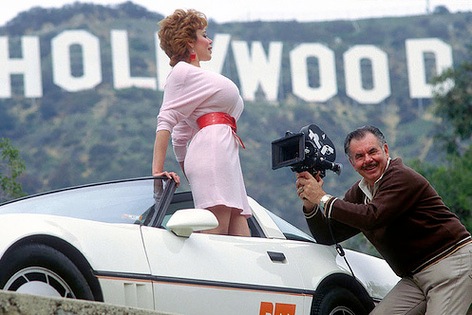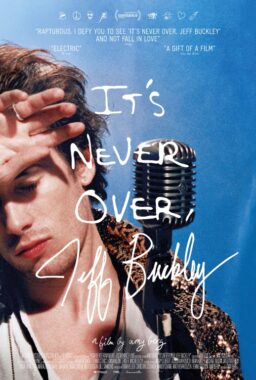At Christmas time last year, as he has every year since her death, Russ Meyer went to visit his mother’s grave. On trips around the country, he often visits the gravesides of old Army buddies, and those who are still living can count on a ticket from him if they can’t afford the fare to the Signal Corps reunion he hosts every year.
Meyer, whose popular image as “King of the Skin Flicks” suggests a leering bra-chaser, is in private the most intensely loyal of friends, who would as soon have dinner with his ancient ex-sergeant as a buxom starlet.
Search through the credits of his 23 films, from “The Immoral Mr. Teas” (1959) through “Beneath the Valley of the Ultra-Vixens” (1979) and you will find the same names over and over: Brummer… He met most of them when they were kids together in the Signal Corps, carrying 16mm newsreel cameras into battle. While some X-rated filmmakers might consider their productions to be invitations to an orgy, a Meyer shoot is conducted more like an Army long march, and the last activity you will find on his locations is sex.
Haji, an exotic danger who has worked on many Meyer films, both before and behind the cameras, remembers Meyer’s invariable warnings to cast members on the first day of shooting: No sex! “He didn’t want us looked tired and depleted in the morning.” When Meyer was making “Faster Pussycat! Kill! Kill!,” he heard that Tura Satana may have slipped out of her motel for a midnight rendezvous, and nailed her room windows shut. “I work on a limited budget,” he told me, “and the picture would be destroyed if the star sneaked out into the desert one night and got bitten on the ass by a rattlesnake.”
While some erotic filmmakers use their films in order to enact elaborate libidinal fantasies, Meyer uses a production, I believe, to recapture the joy he felt during the most formative and enjoyable period of his life–the war. It was then that he formed lifelong friendships, discovered his skill as a cameraman, and experienced, in a French bordello, his sexual awakening, with a partner who became the archetype of the ideal R.M. woman.
He stages his films like military operations, casting himself as the tough sarge who blows the bugle at dawn. And he deliberately selects difficult and inaccessable locations; one of the most familiar sights in his films is a beautiful woman wading in a muddy river (“Lorna”) or climbing a barren mountainside (“Supervixens”). He loves shots which begin with a landscape the size of Monument Valley and end with a closeup of breasts that would fill the Grand Canyon.
Meyer is, of course, the most famous breast man of his generation; maybe of any generation. When I met him in 1968, he was casting for “Cherry, Harry and Raquel,” and his ad in Daily Variety mentioned only one prerequisite for female applicants: “BUILT!” When he was asked once where he found the amazingly contoured women in his movies, he replied, “After they get above a certain cup size, they find me.” Even in these days of silicone enhancement, his original superstars, like Ushi Digard, Tura Satata, Cynthia Meyers and Lorna Maitland still, as he once put it, “hold the record at Lane Bryant.”
In an unexpected way, Meyer’s love of breasts has been his fortune. His films have never expressed much interest in what goes on below the belt, and when hard-core porno came along, he included himself out. He says that was because the mob controlled the nation’s porno houses and he didn’t want to share his profits with them. I also believe he was simply not interested: Like all the artists who have idealized the human body, he was more interested in form than function.
Although Meyer for many years was the target of feminists, in recent years revisionist critics have argued that his films are, in fact, pro-woman. Even such a committed feminist as B. Ruby Rich, writing recently in the Village Voice, devoted a full page to a reevaluation of “Pussycat,” a film she once despised but now values because of its images of strong women exercising their wills.
If there are mindless sex objects in an R.M. film, they are invariably men. Starting with his first hero, the inoffensive false-teeth deliveryman in “Mr. Teas,” his male leads are tantalized, tempted, dominated, thrown around, tortured, used, abused, cast aside or simply smothered by strong, powerful women. Examine the insecure Harris Allsworth in “Beyond the Valley of the Dolls;” the weak husband whose wife attacks the hood of his truck with an ax in “Supervixens,” and the student husbands in “Lorna” and “Ultravixens” who would rather sit up late tapping out sums on a calculator than respond to the hungry invitations of their wives. The hero of that last film is so witless he doesn’t even recognize his own wife when he encounters her as a night club stripper. In a Russ Meyer film, the Los Angeles critic Kevin Thomas once wrote, the women meet their men, use them, and move on.
If Meyer is a sexist pig, then so is Madonna, who has popularized the same images in many of her reincarnations. Meyer is almost unique in the world of popular eroticism in not seeing women as passive victims, but as aggressive and demanding sexual beings who demand that their needs be met. One of the reasons “Faster Pussycat! Kill! Kill!” is having such a startling box office revival around the world is that is argues for those images in such a dramatic way.
Like all of Meyer’s best films, it depends partly on happy casting: Tura Satana, half-Japanese, half-Apache, tall and striking, with a black belt in karate and a startling bustline, was the kind of woman who had simply not been seen on the screen until Meyer cast her as his lead. Audiences cheer as she attempts to crush the hapless hero against the side of a barn, her stillettoed heel jamming down on the acceleragor of her Porshe as the hero’s muscles bulge in an attempt to save himself, and Meyer uses quick cuts between the gas pedal, the muscles, the car wheels spinning in the sand, the hero’s desperate face, and Satana’s fierce dark eyes.
“The greatest artistic influence on my work,” Meyer told me, “was Al Capp’s ‘Li’l Abner.’ Daisy Mae was my ideal of the perfect woman, except that she should have been more aggressive.” In Meyer’s version of Dogpatch, all of the characters are exaggerated cartoons, trapped somewhere between centerfold and satire–like the radio revival preacher played by Ann Marie in “Ultravixens” (“place your afflicted parts on the radio, bretheren!”), who in one unlikely scene broadcasts a total immersion ceremony direct from her bathtub.
Meyer holds the rights to all of his films, and they have made him very rich. He does not offer discounts to video stores or even deal with wholesalers: If you want a Meyer film, you get it from R.M. For the last 10 years, while directing an MTV video and shorter films starring such discoveries as the Hungarian beauty Tundi and the American strippers Melissa Mounds and he has been trying to get another feature off the ground. At one point director John Landis, a Meyer admirer, was on board as exeuctive producer of a project at Carolco, but the financing fell through. His current project is “The Bra of God,” with a title (I modestly admit) by me.
Most of his time in the last decade has deen devoted, however, to his massive autobiography, A Clean Breast. Meyer’s life is as thoroughly documented as Winston Churchill’s. Although he spends much of his time at his sprawling home in Palm Springs, he also lives and works in the Hollywood Hills in a home once described by another admirer, director John Waters, in the book Shock Value, as the “Russ Meyer Movie Museum.”
Walk inside, and you’ll be bombarded with images from his films: Framed posters in many languages cover the walls and ceilings, and there are framed souvenirs from each of his films: Ice tongs, a steel-cup jock strap, a room key, an old Rolleiflex, even Mr. Teas’s false choppers. Massive shelves groan under the weight of dozens of scrapbooks documenting every chapter of Meyer’s life, and he has drawn on this material in writing an autobiography that is generously illustrated with literally thousands of drawings and photographs–many of old Army buddies, but more, readers will be relieved to learn, of his buxom stars and playmates.
The book is finished. But its publication date has been pushed back repeatedly, primarily because Meyer wants it to stand through the ages as a classic example of the printer’s art. It will be leather-bound, slip-cased, and printed on expensive art paper guaranteed to be acid-free, with a shelf life of a millenium. It will be produced by the world’s finest art book publishers, in Hong Kong. It will cost hundreds of dollars.
And it will not be sold in bookstores. “I once had the privilege of directing a great lady, Miss Yvonne De Carlo in “The Seven Minutes’ (1970),” Meyer told me. “One day I was walking through a bookstore and I saw her autobiography, marked down 50 percent. That will never happen to my life! I’m selling it myself. No review copies, no press copies, cash only. To be sure they’re sincere.”
But, Russ, how will people be able to order it? I asked.
“They can call me up.”
But your number is unlisted!
“That’s their problem.”
One of the remarkable things about Russ Meyer’s films is that they continue to live and play, long after the other work of the soft-core era has been forgotten. That is partly because of their craftsmanship, partly because of Meyer’s leading ladies, and partly because of a spirit of paramilitary committment that can be sensed as the cast and crew struggle through rugged terrain to enact their rural melodramas. But the central reason, I believe, is that Meyer is an auteur whose every frame reflects his own obsessions. Like all serious artists, he doesn’t allow any space between his work and his dream.












